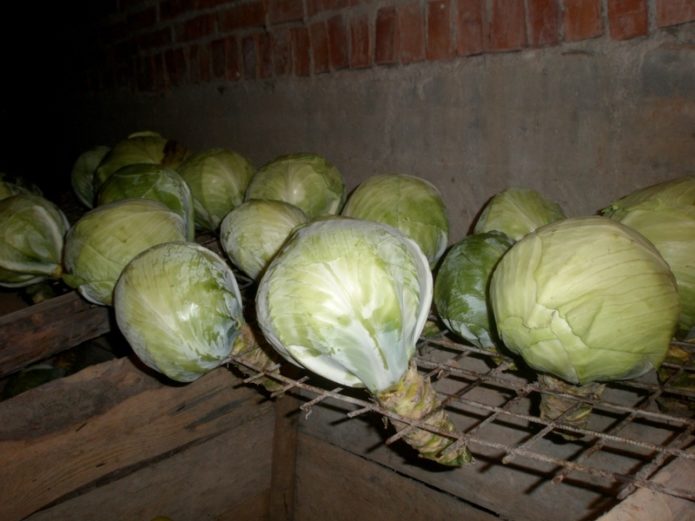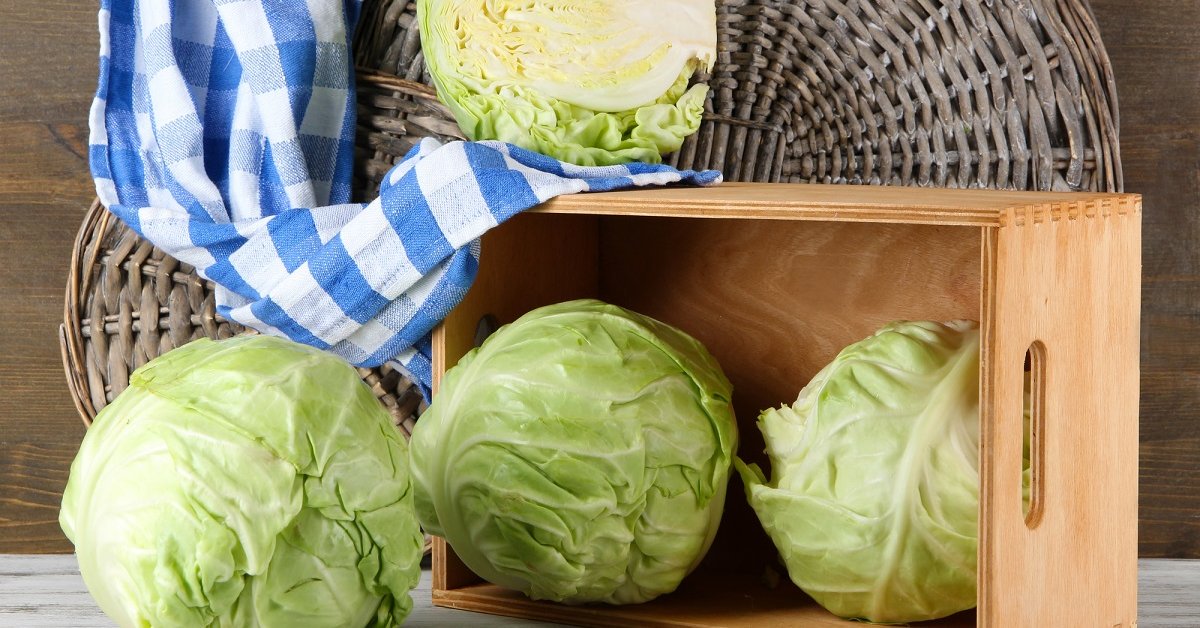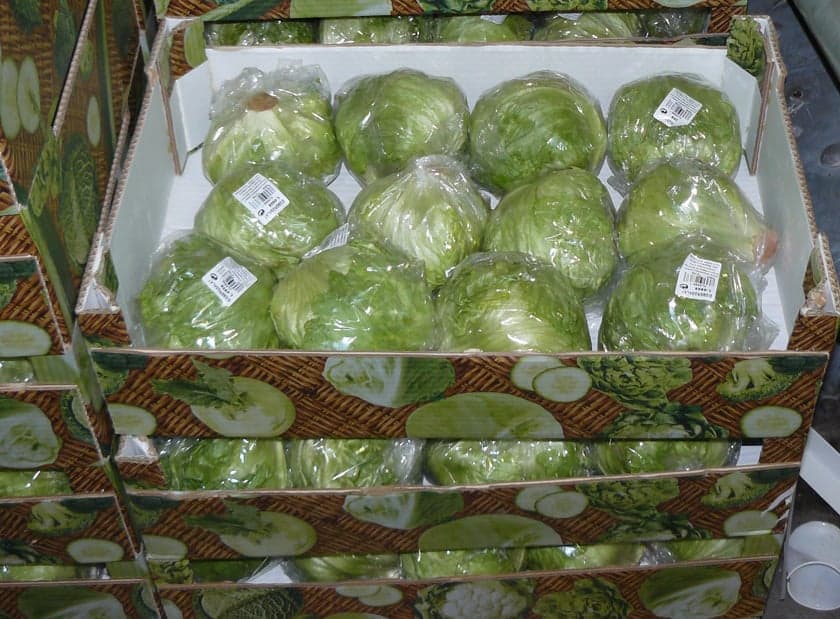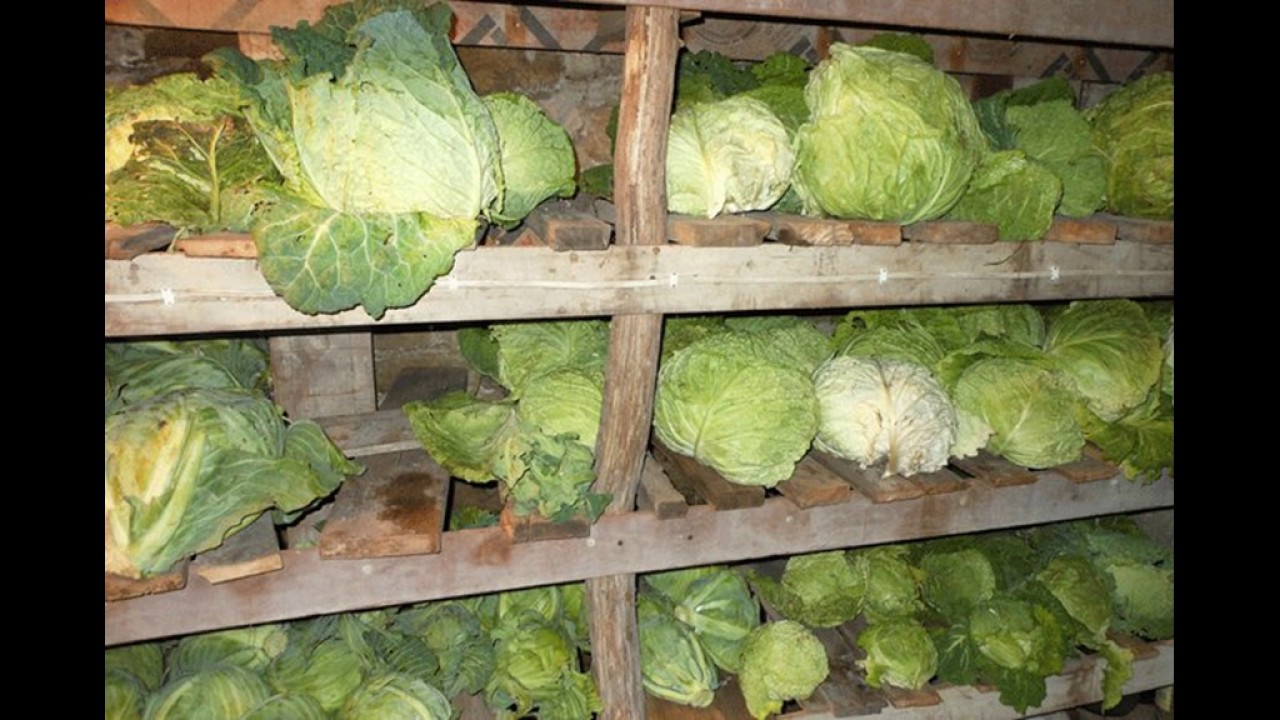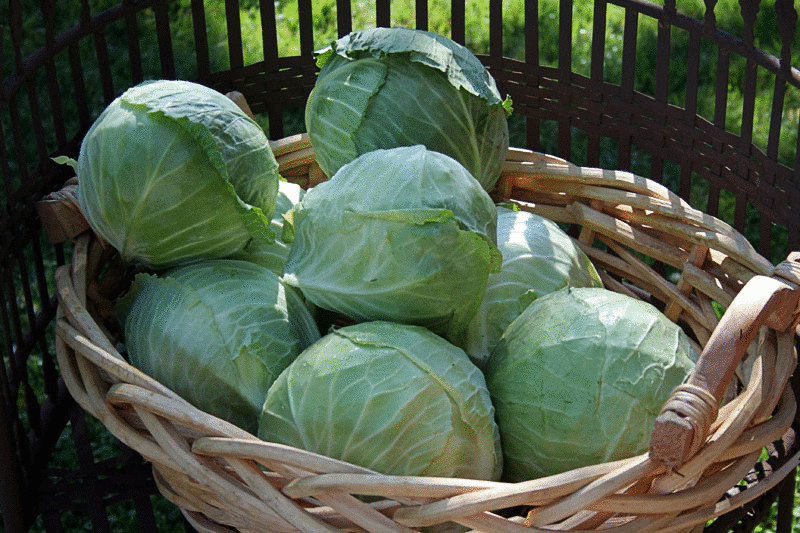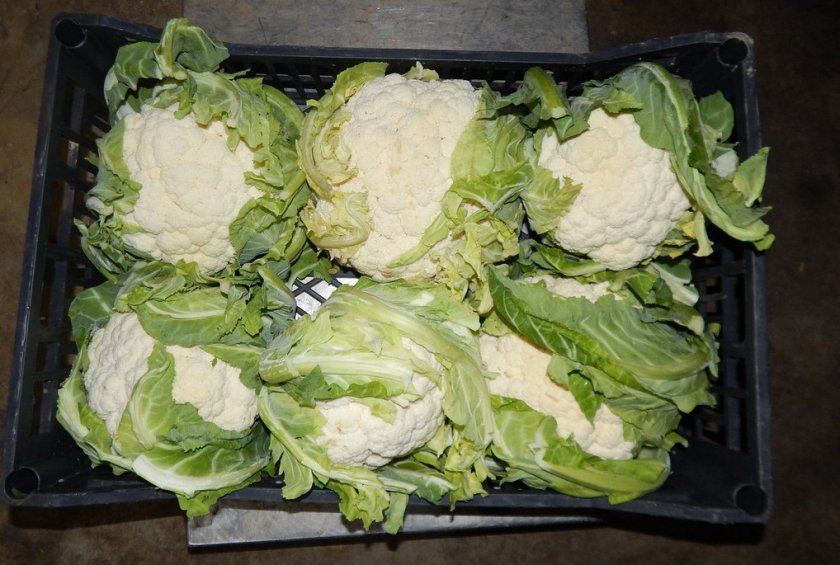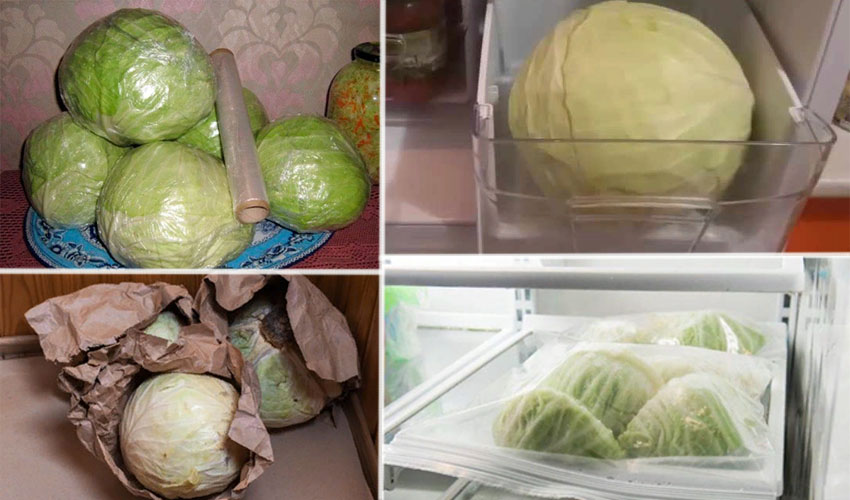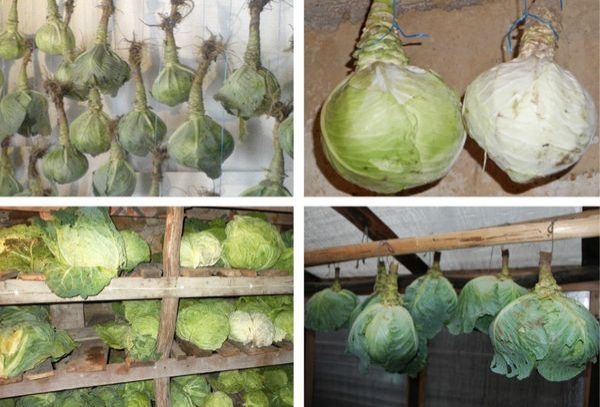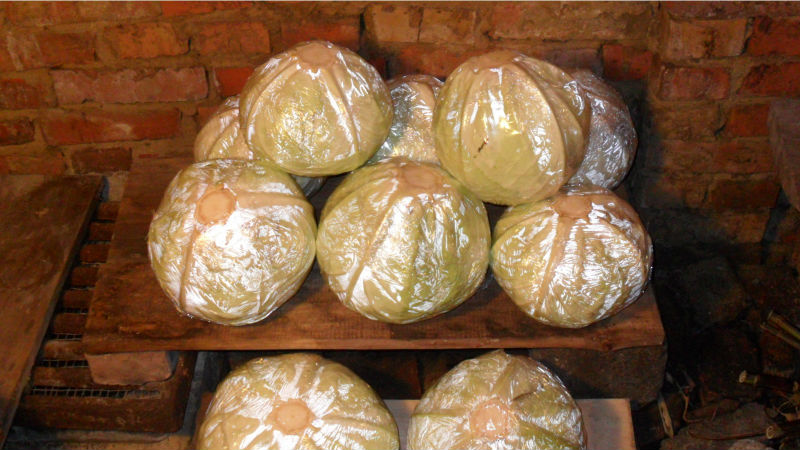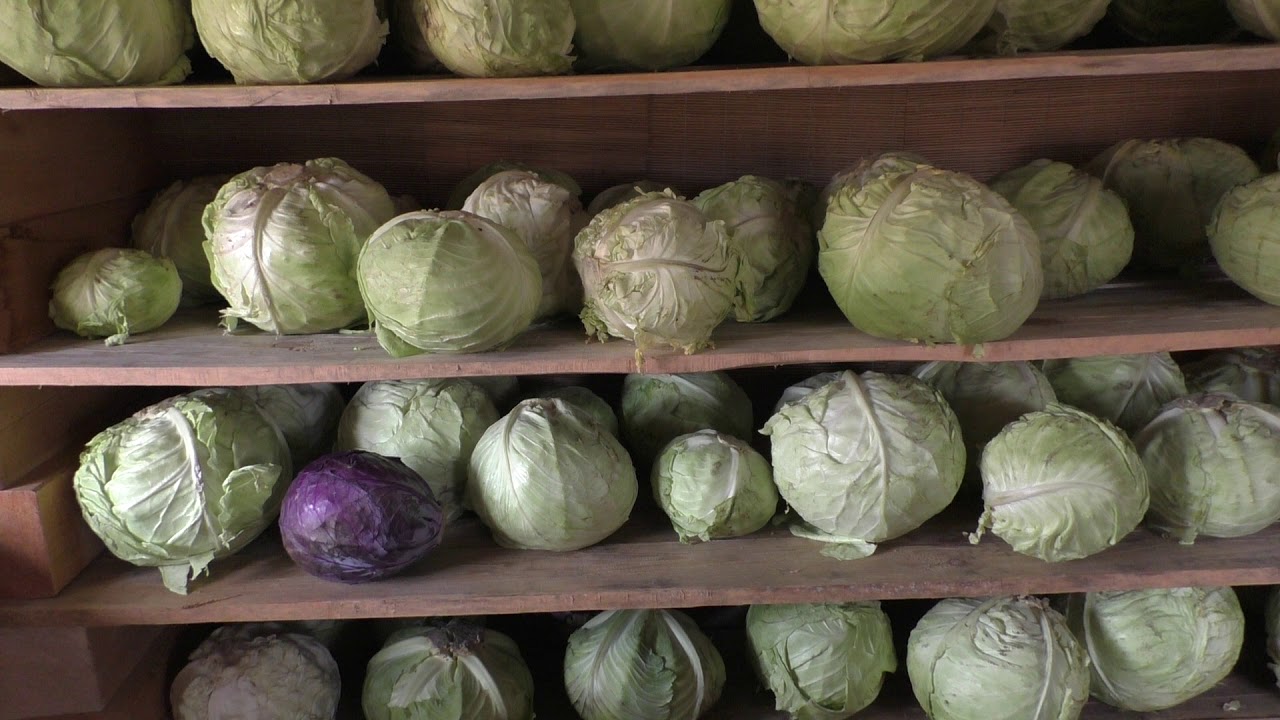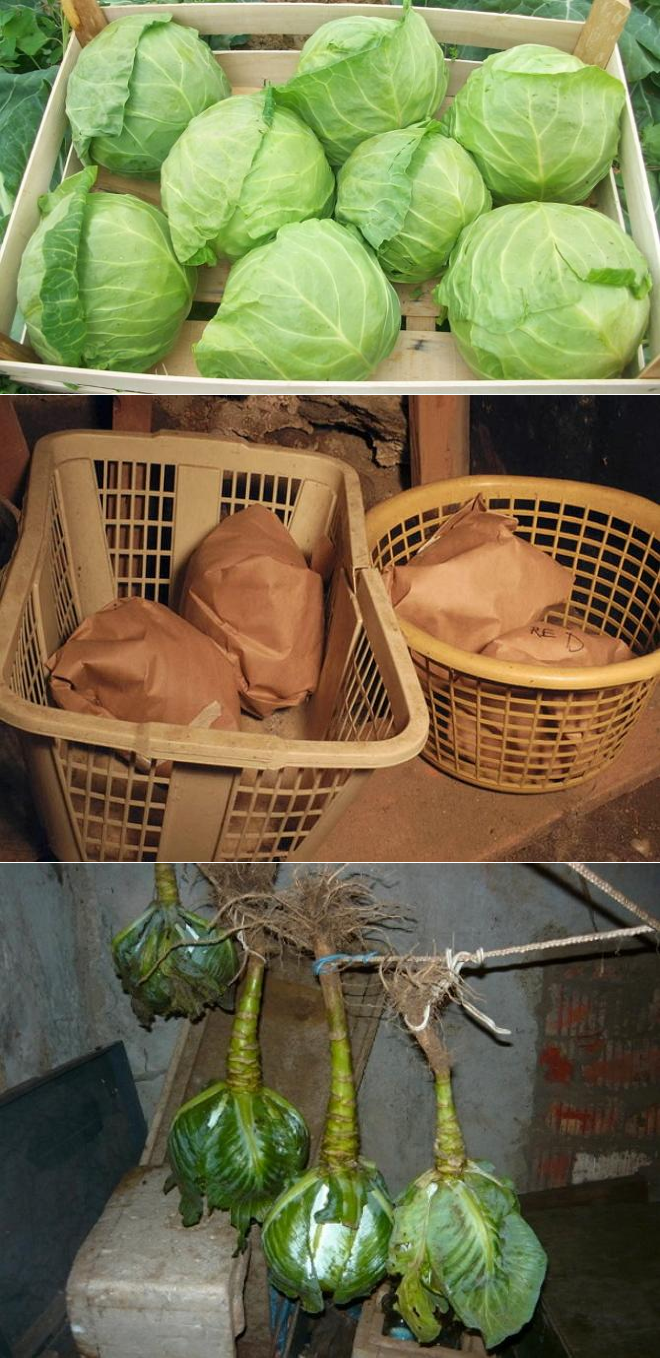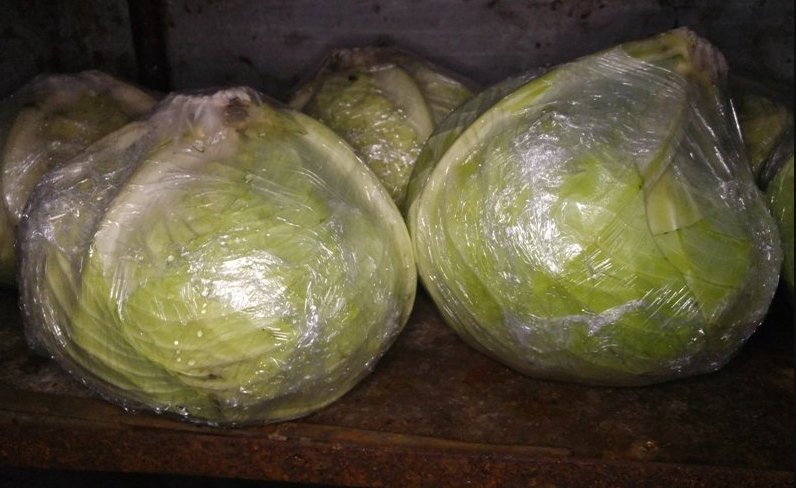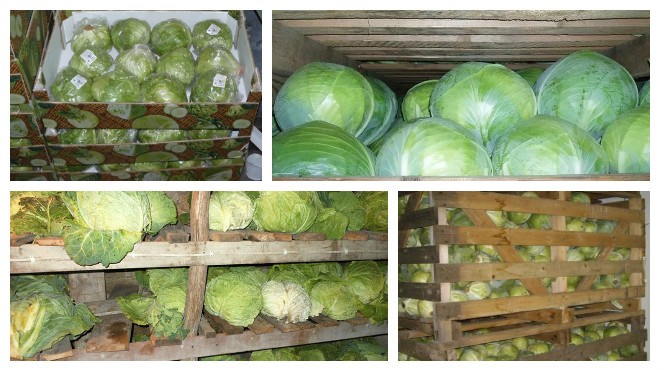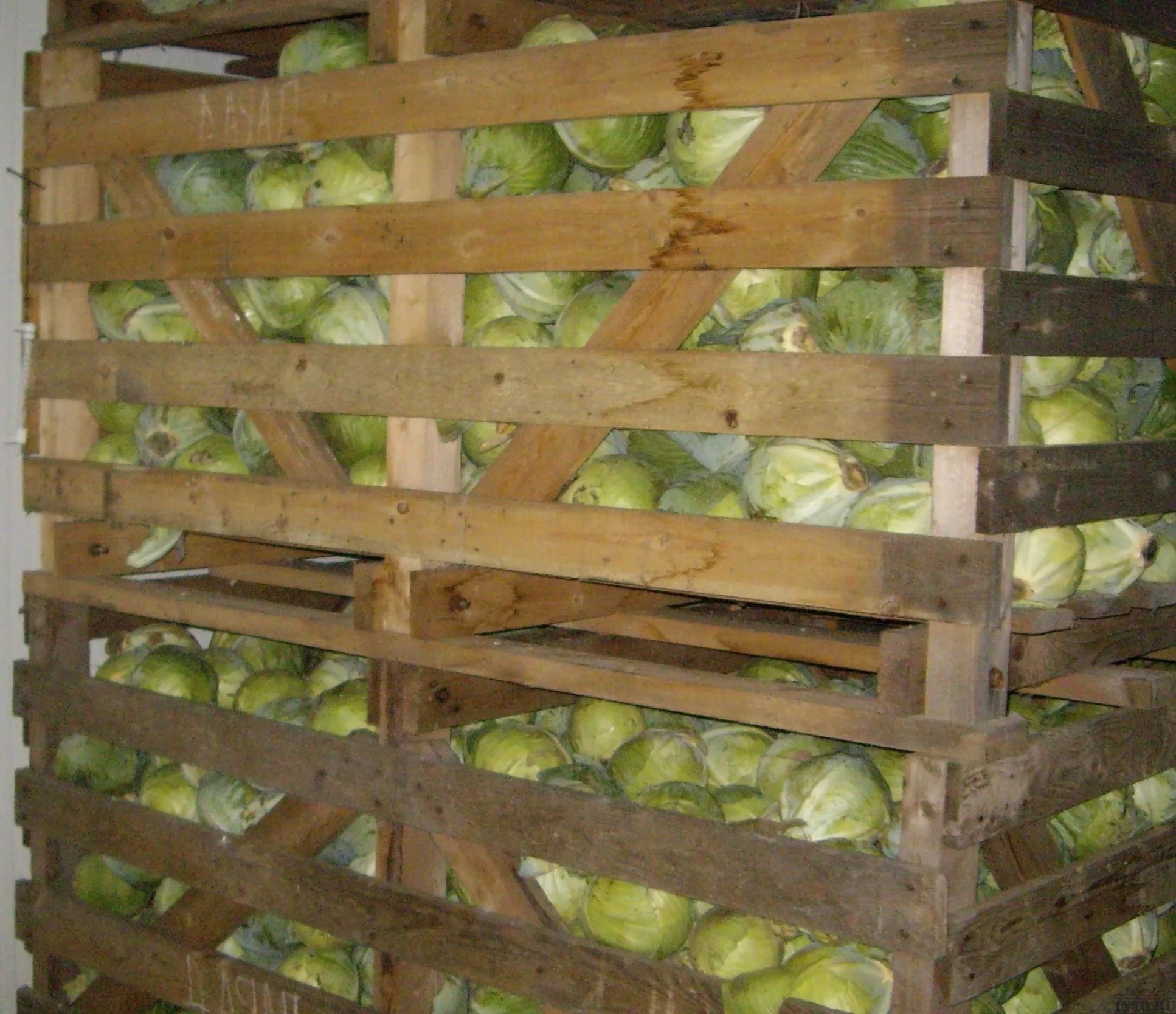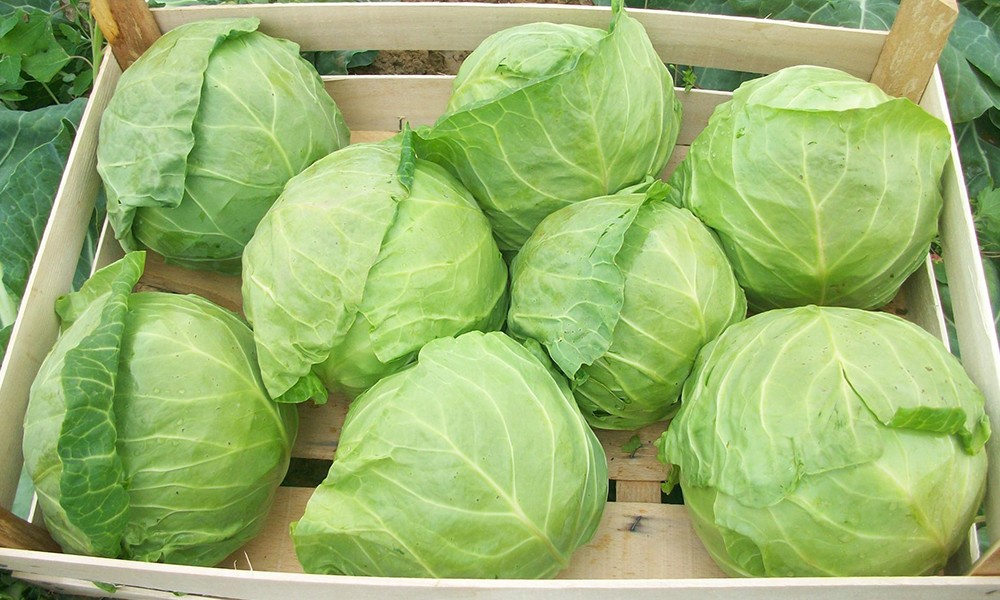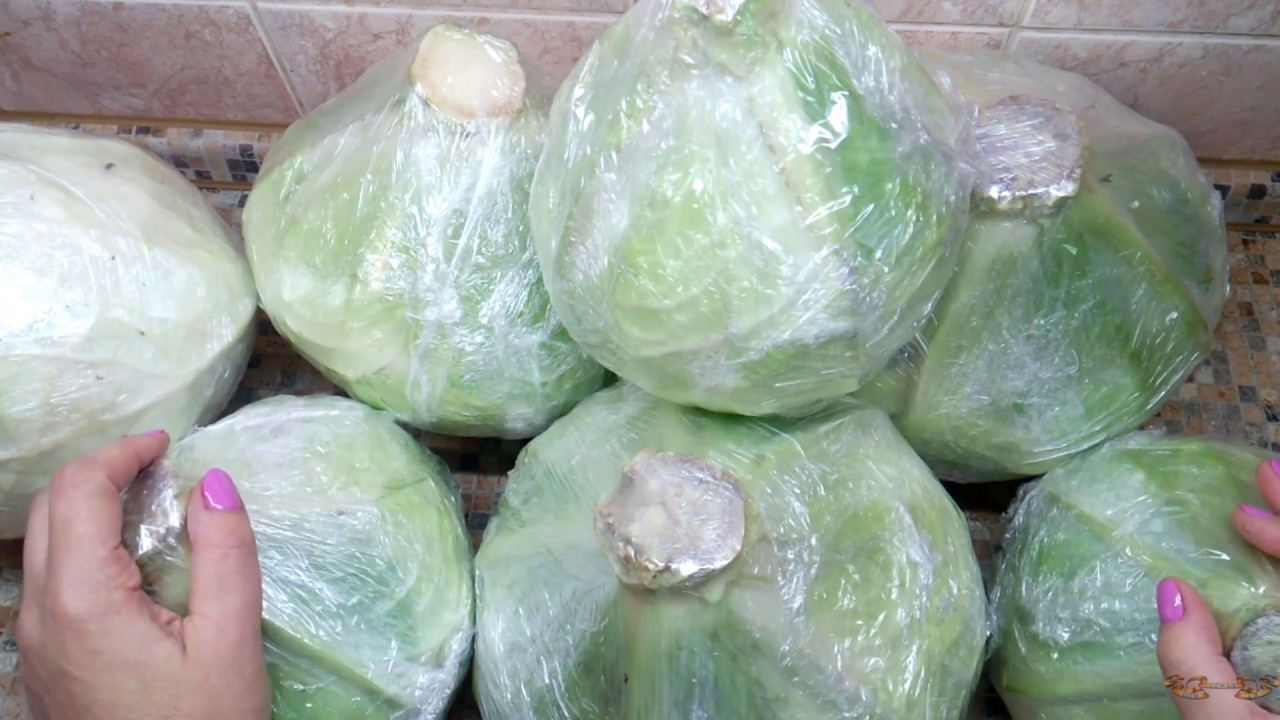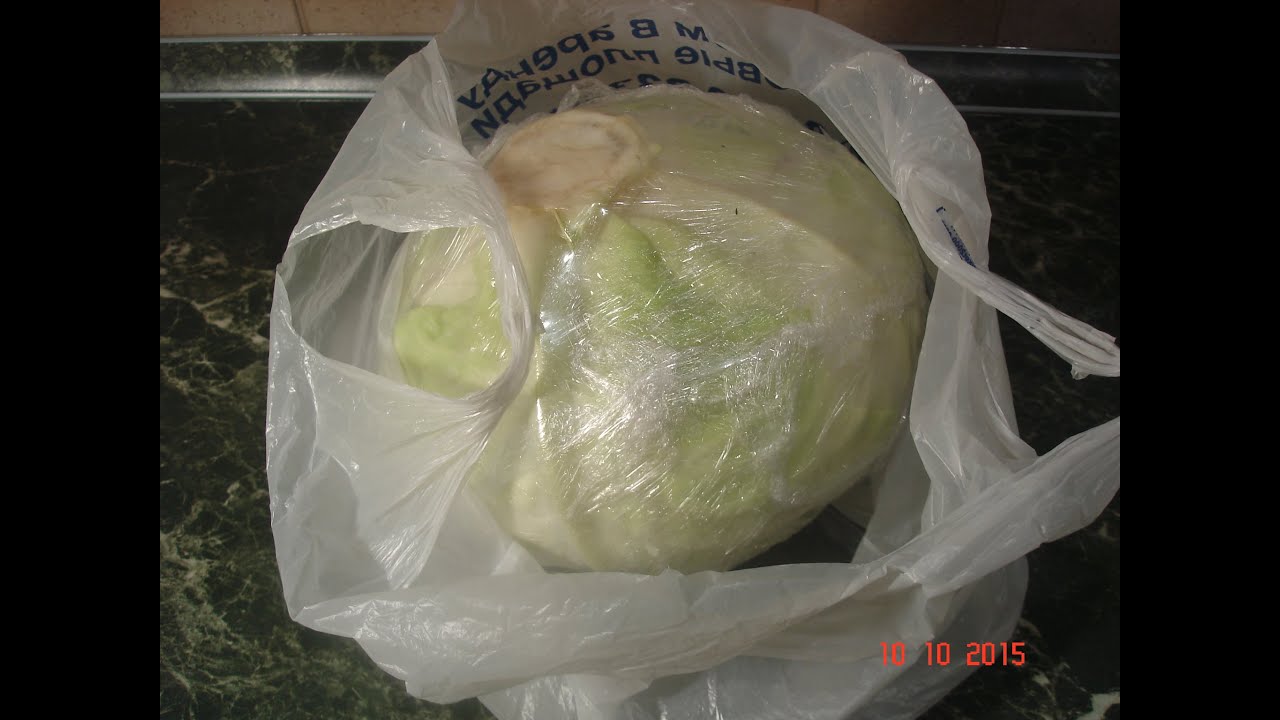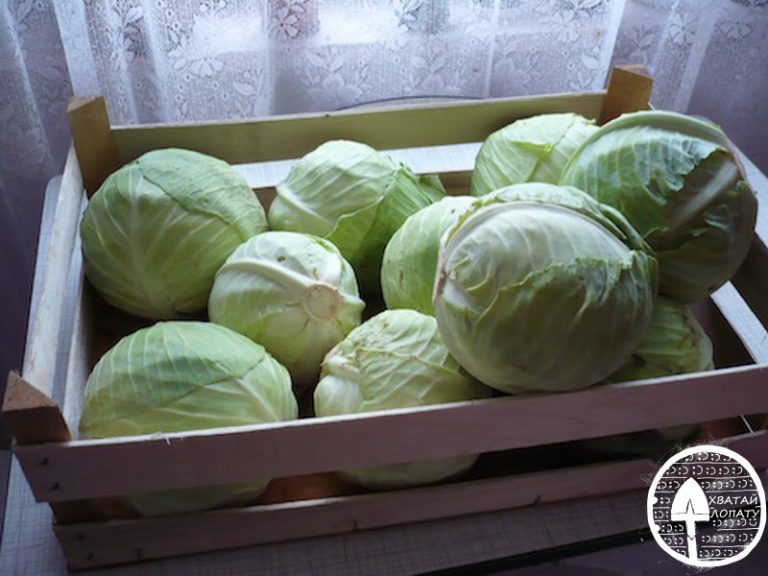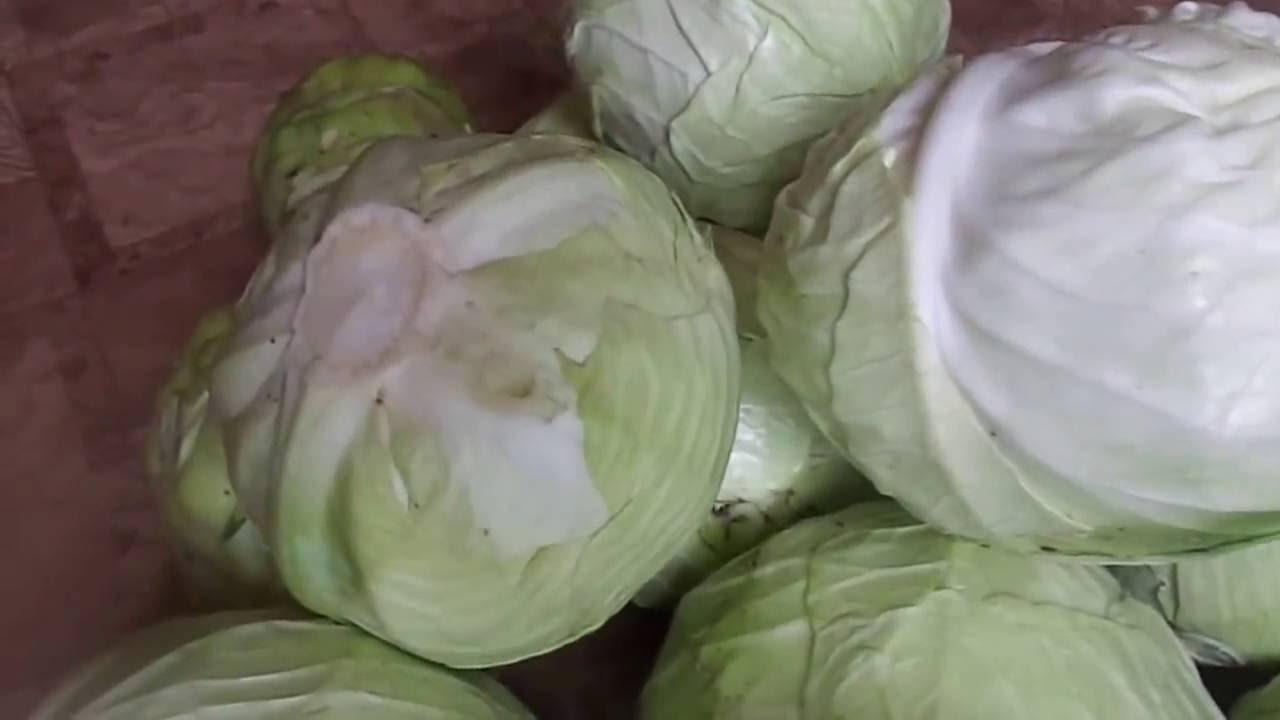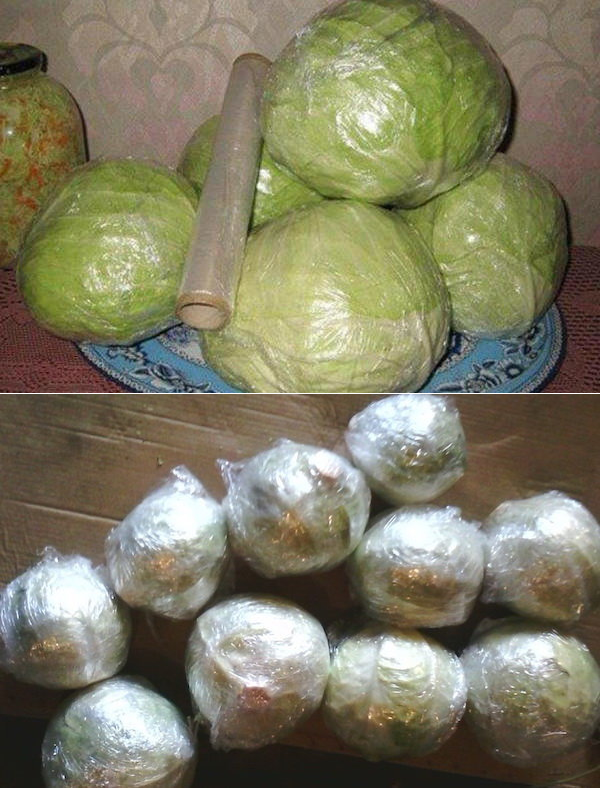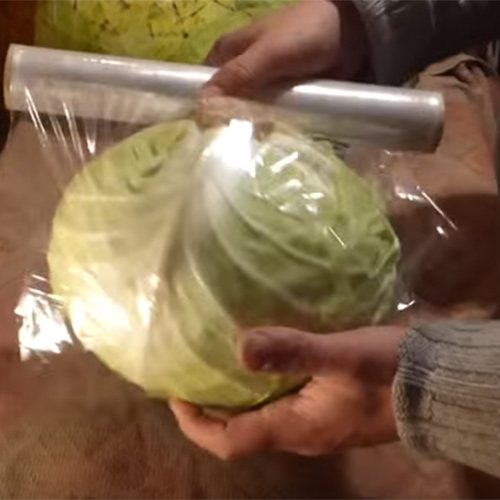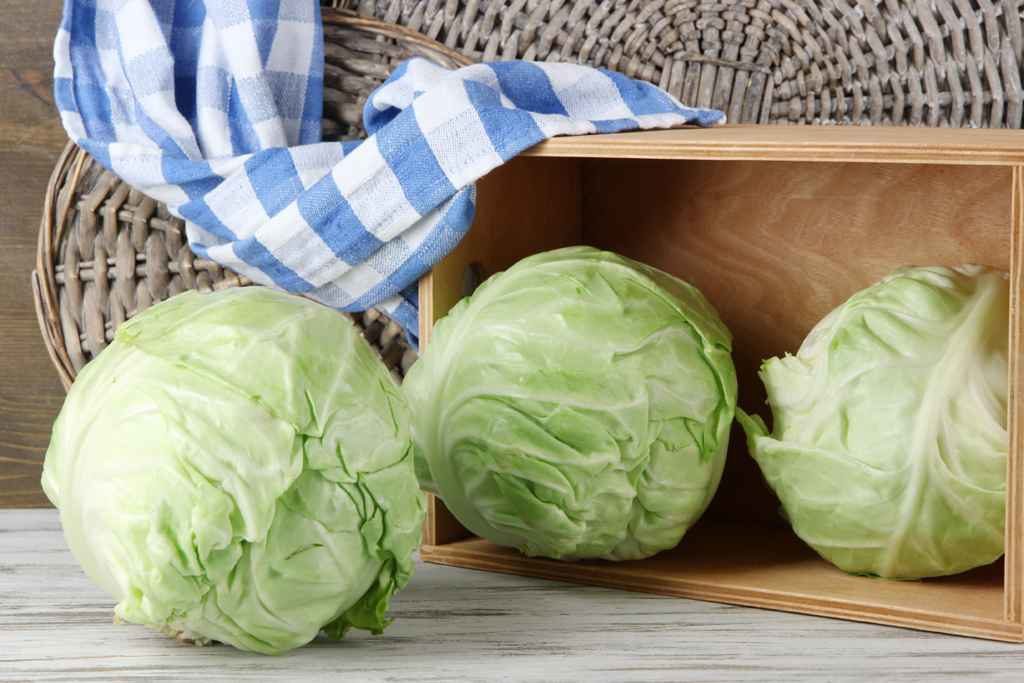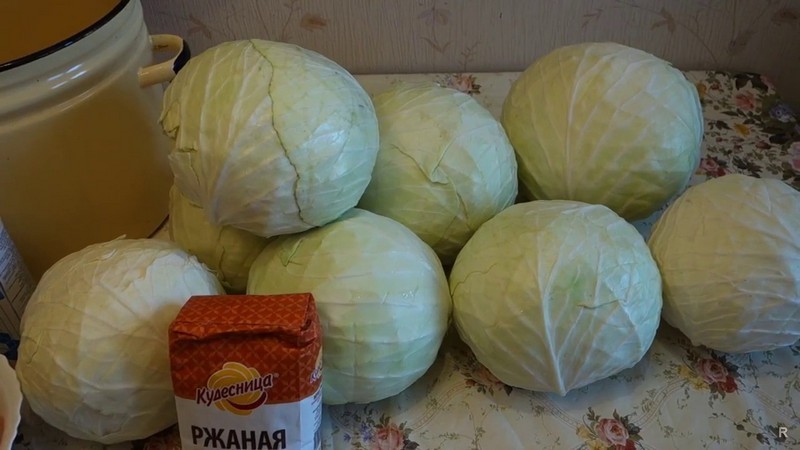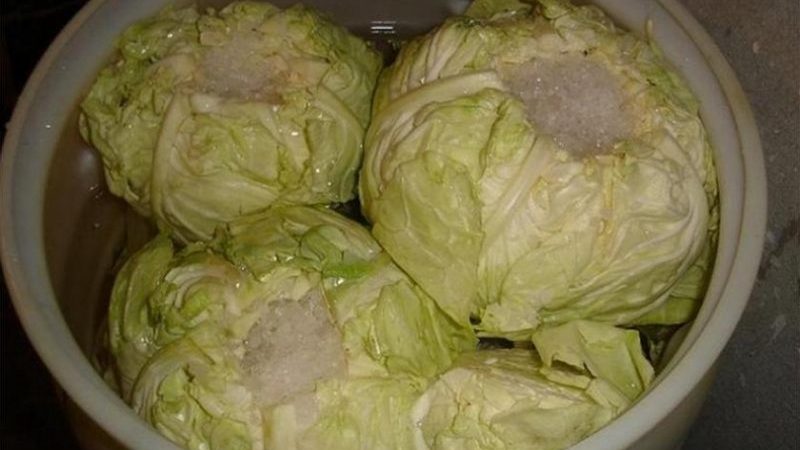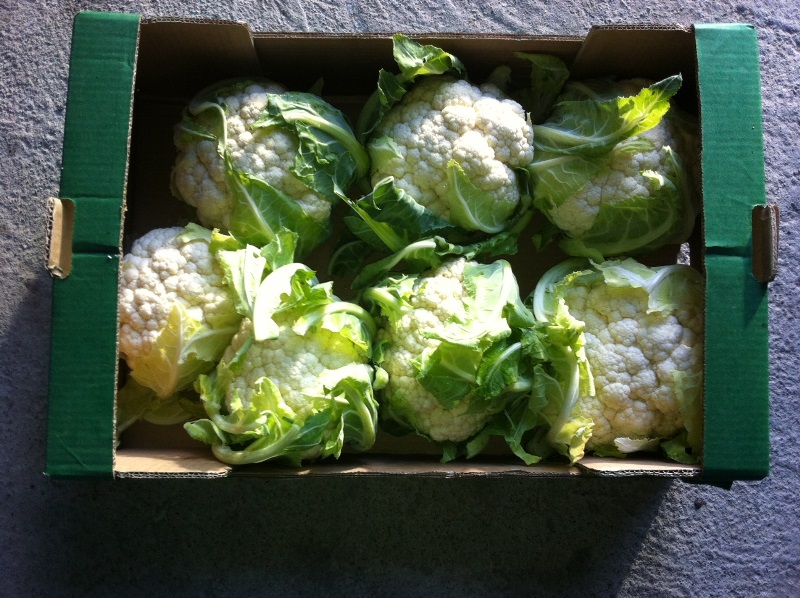Where can you store
Cabbage harvest harvested for consumption in winter can be preserved:
in the basement and cellar, placing vegetables on shelves, hanging from the ceiling. With a rich harvest, cabbage can be stacked in a pyramid-shaped stack, stubs up. These rooms must first be prepared for laying vegetables - dry, drive out rodents, disinfect with whitewash, you can fumigate with sulfur. In a good underground room with a cold snap, the required temperature and humidity are established, which allow avoiding crop losses. In a prepared basement or cellar, cabbage lasts about 8 months;
Did you know? When stacked on an area of 1 sq.... you can place up to 200 kg of cabbage.
- it is also possible to store cabbage in the pantry for some time. This method is suitable for apartments. In a relatively cool and dry place, it is better to store the vegetable by carefully wrapping it in cling film or parchment. The forks must not be laid out very tightly to ensure air circulation. In such conditions, vegetables can be stored for six months;
- in the refrigerator, this vegetable must be placed in the freshness zone (available in all modern models), where you can create the desired temperature to preserve it. If there is no such place, put the forks in the refrigerator section with a minimum temperature. Each head of cabbage must be packed in parchment or plastic wrap. So the vegetable is stored for no more than 30 days;
- on the balcony, if it is insulated, you can maintain a constant temperature and store the forks, also wrapping them with paper or film. During a severe cold snap, cabbage must be laid out in a closet or covered with fabric insulation. The shelf life is on average 5 months;
- in an earthen trench - such storage of cabbage is suitable for large heads of cabbage: they do not take up space in the room. But in the ground, the heads of cabbage become damp, rot and freeze under very severe frosts, and it is unlikely that it will be possible to quickly get the heads of cabbage from such a shelter from such a shelter in bad weather. With this method, you need to dig a trench 0.5 m deep and 0.6 m wide on a hill, lay a layer of straw on the bottom and cabbage forks in two rows on top. Cover the top with straw and put a wooden shield. Throw soil over it with a thickness of at least 0.2 m.
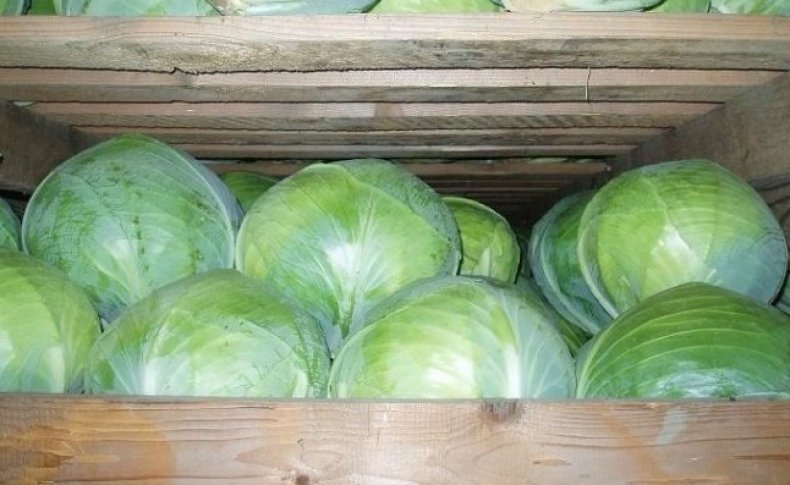
Ways to store cabbage at home
At room temperature, kohlrabi cabbage can stay fresh for only a few days, so for longer storage, the vegetable must be kept in special conditions. You can process the product by making tasty canned preparations from it, but at the same time kohlrabi will partially lose its taste and useful chemical composition. In order to be able to feast on fresh vegetables until the very cold weather, they use various methods of storing it, listed later in the article.
Learn about recipes for preparing kohlrabi cabbage for the winter.
In fridge
In a city apartment, you can increase the shelf life of fresh kohlrabi cabbage using a refrigerator. This method allows you to preserve the freshness of the product for up to 5 weeks, provided that the stems have been properly prepared.
Basic rules for storing kohlrabi in the refrigerator:
- lightly shake fresh vegetables from dirt and cut off their tops - while it is recommended to leave small cuttings so that harmful microorganisms do not penetrate through the damaged pulp;
- wrap the stems with thick paper or a damp cloth and put them in a plastic bag, leaving it slightly open - this will prevent rot on the cabbage as a result of air stagnation;
- the cut tops can be folded into a separate bag and also placed in the refrigerator;
- you need to store kohlrabi in the vegetable drawer located at the bottom of the refrigerator.

In a cellar or basement
The most common way to store large quantities of fruit is in the cellar or basement. In such a room, you can create optimal microclimate conditions under which the product will be stored for 3-5 months.
Important! To keep the kohlrabi juicy and tasty during storage in the cellar, it is recommended to place it with its roots down.
Basic rules for storing kohlrabi cabbage in a cellar or basement:
- prepared stems are folded in a box or wide basket, placing them not too tightly to each other;
- a layer of wet sand is poured in a container with cabbage so that it partially covers the vegetables, and then cover them with a film, leaving a hole for free air access;
- boxes and baskets with cabbage are recommended to be placed on racks or grating - this will protect the product from rotting and rodents;
- you can scatter a layer of wet sand about 7-10 cm thick on the floor of the storage and spread the kohlrabi on it, placing them at a short distance from each other, but this storage method is allowed to be used only in the absence of pests and rodents in the room;
- each stem plant can be placed in a net and suspended vertically from the ceiling at a distance of at least 3 cm from each other - while air circulation should be carried out in the cellar so that the suspended cabbage does not rot.

On the balcony
If in a city apartment there is a glazed balcony or loggia, on which the air temperature is above zero during the winter, then they are also suitable for storing the product. But this method allows you to keep the freshness of the product for only 1 month.
Basic recommendations for storing stem crops on the balcony:
- you can hang the kohlrabi vertically from the clothesline on wire hooks, securing them to the root of the vegetables;
- cabbage keeps well in wooden boxes;
- if the air temperature on the balcony drops below 0 ° C, then it is imperative to provide a heating system.
 Vegetables should be placed at a distance of 3-5 cm from each other so that they do not start to rot
Vegetables should be placed at a distance of 3-5 cm from each other so that they do not start to rot
In the freezer
Fresh kohlrabi cabbage is stored for the longest time in the freezer. At the same time, it partially loses its original taste, but you can use a frozen vegetable for 6-9 months.
Did you know? Kohlrabi leaves contain 2–3 times more vitamins than stalks, so the tops of plants are recommended for making fresh salads.
Step-by-step instructions for freezing stems are presented below:
- Rinse the cabbage thoroughly under running water and peel it.
- Cut the fruit into small pieces. Dip them in boiling water for 2-3 minutes, and then immerse them in a container with ice water.
- Discard the blanched cabbage pieces in a colander to drain off excess water. After that, lightly dry the vegetables by blotting them with a napkin.
- Fold the kohlrabi into plastic containers or plastic bags, avoiding moisture getting into the container. Place in the freezer.
 You can grate the stalks on a coarse grater and freeze them without blanching - this will keep the maximum amount of nutrients in the cabbage.
You can grate the stalks on a coarse grater and freeze them without blanching - this will keep the maximum amount of nutrients in the cabbage.
Conditions and storage temperature of white cabbage in winter
White cabbage is preserved with 3-4 green leaves tightly fitting the head of cabbage, and the stump is left 2-3 cm long from the last leaf left. Lay cabbage in a layer of 5-7 heads of cabbage (pyramids) at a temperature of +1, -1 degrees. If there are shelves, cabbage racks are placed on them in 2-3 layers with free air access to it. Cabbage is well kept hanging on slats. In this case, the stump is not cut off. Decaying leaves are removed.
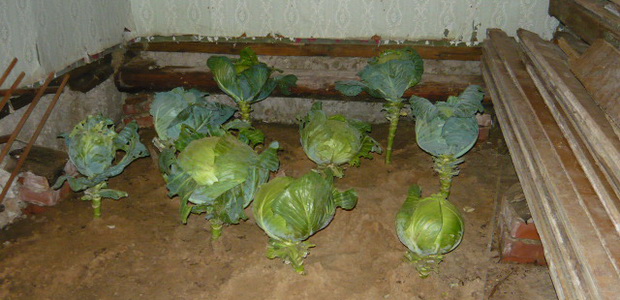
In regions with mild winters, storing cabbage in the basement is difficult. In these areas, it is advisable to grow cabbage. For this, late cabbage is sown 3 weeks later than generally accepted terms. Before the onset of frost, plants with loose heads of cabbage are selected and pulled out of the ground with stalks. Then they dig grooves 20-30 cm deep, as wide as the diameter of the head of cabbage. Lay the cabbage heads down with all the whole and healthy leaves of the rosette. Then they cover it with earth, removed from the groove, with an additional layer of 30 cm. In frosty winters, the cabbage is covered with fresh manure or straw. By February - March, the head of cabbage increases in weight, becomes dense and white.
The most common and proven ways to store cabbage include the following:
Storage on shelves in the cellar is the simplest type of cabbage "wintering", in which the heads of cabbage are cleaned of the upper green leaves, leaving only 2-3 pieces. During the winter, the fruits are periodically turned over to the other side. Moreover, the longer the stump, the longer the head of cabbage will be stored.
Before laying the heads of cabbage in the cellar, it is advisable to process them in order to get rid of harmful microorganisms. To do this, each head of cabbage, holding by the stump, is dipped for a few seconds in a solution of whitewash lime (100 g of lime per 5 kg of cabbage) or pollinated with chalk (proportions are identical).
The next method suggests, without removing the upper leaves, wrap each head of cabbage in paper and lower it into the cellar, and during storage, check the condition of the fruits for moisture. If the paper gets wet, the head of cabbage must be unfolded, removed one layer of leaves, wrapped in a dry "package" and put back.
With another method, the stumps are cut off almost closely, stepping back from the fruit about 0.5 cm, and each head of cabbage is wrapped with a thin cling film in 2-3 layers. After that, the cabbage can be lowered into the cellar or stored in any other cool place, periodically, as in the paper version, checking the fruits and removing rotten leaves.
You can also give some more general advice:
- late-ripening varieties are used for long-term storage;
- cabbage heads are never washed, but only wiped with a dry cloth;
- cabbage is not stored in boxes, as it will quickly rot in them.
As for cauliflower, it is stored for no more than 2 months. It can be wrapped in a dense plastic bag of 2-3 heads, making 2-3 holes in the "package" of 0.5-1 cm. The method with cling film is no less effective.
Optimal storage conditions for cabbage - air humidity 90%. The storage temperature of white cabbage is from -1 to 2 ° C. There are several methods of storing this vegetable crop. The first is the arrangement of the heads of cabbage in limbo. It is necessary to collect the cabbage from the garden along with the roots before the onset of the first frost, remove the top sheets from the forks and hold it in the open air for a while. After that, tie the roots with twine, to which attach hooks made of wire. The heads of cabbage should be suspended from the ceiling of the cellar or basement so that they do not touch each other.

You can put the forks prepared in the same way on wooden shelves (just do not make hooks) and remove the leaves as they deteriorate throughout the storage period.
Another way of storing white cabbage is often used. Tie parts of the cut roots with twine, make a loop on top. Remove the top leaves, immerse the forks entirely in a clay solution similar in consistency to sour cream, and dry in a suspended state in a well-ventilated area. Hang the dried cabbage from the ceiling in the cellar or basement.
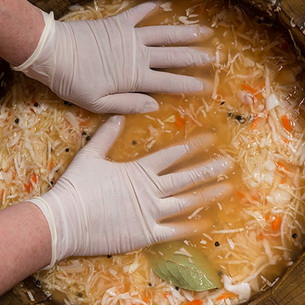

Salted or sauerkraut in barrels should be stored at 0-1 ° C. Care must be taken that the brine completely covers the product, otherwise it will lose vitamin C. If the temperature in the cellar or basement drops sharply, the cabbage will be frozen, and it will definitely need use after thawing.Re-freezing will destroy all vitamins.
Freezing methods
There are 3 main methods, which we will discuss next.
Whole head of cabbage
Suitable for cooking with whole leaves or for chopping after defrosting.
The procedure for preparing a vegetable for freezing in this way is simple:
- Remove the stump and outer leaves.
- Rinse the remaining head of cabbage, wipe and dry.
- Put the prepared head of cabbage in a bag or wrap in plastic and place in the freezer.
Find out how to properly store cabbage in the cellar and in the apartment.
Leaves
Cabbage harvested in this way is used for cooking dishes where the whole leaves are used.
The procedure is as follows:
- Remove outer leaves and stump from the head of cabbage, rinse.
- Place the resulting forks in boiling water for 2–4 minutes, depending on the size of the head of cabbage.
- Disassemble the foliage and put it in bags.
- Place in the freezer.

Chopped
For the preparation of soups and stewing, the semi-finished product can be prepared already in chopped form.
Procedure:
- Rinse the head of cabbage, remove the outer layer of leaves, dry.
- Chop and place in plastic bags (containers).
- Put in the freezer.
The method has a peculiarity: chopped cabbage can be combined with other vegetables. For example, a combination with bell pepper is an excellent semi-finished product for winter borscht. In addition, retail chains rarely sell ready-made mixtures of frozen vegetables with white cabbage, more typically a combination of other vegetables - with cauliflower or Brussels sprouts.
Place and container
Before the procedure, it is necessary to prepare the packaging and storage location. Plastic bags or cling film are suitable as packaging. You can also use plastic containers, but they will take up more space. When it comes to storage space, there are only two options: a fridge freezer or a household freezer.
Freezing rules
Having decided to resort to the method, you should know how to properly freeze a vegetable in order to maximize its beneficial qualities and appearance.

Freezing preparation
To get a good frozen convenience food, you should start by choosing good quality starting material and follow some simple rules:
- To begin with, you should select the most suitable heads of cabbage: no external damage, rounded, slightly elongated or flattened, having a dense structure.
- Inspect for signs of rotting and the presence of insects (their traces of vital activity).
- Remove outer leaves.
- Rinse the heads of cabbage with tap water.
- Wipe thoroughly with a thick soft cloth and allow to dry.
Temperature
The correct storage temperature for frozen cabbage in any form is up to –18 ° С. This is the typical temperature in the freezer compartments of modern household refrigerators. If the freezer has three drawers, the two lower ones are suitable for freezing. At a temperature of 0… –8 ° C, the semi-finished product is stored for no more than 90 days.
Shelf life
If the vegetable is frozen in accordance with the technology, while you initially chose high-quality raw materials, it can be stored for up to 300 days. That is, in the event that you put the product in the freezer in October, you need to use it until mid-summer.
Important! The re-defrosted semi-finished product is not subjected to freezing. In this case, you will get an ice mass devoid of useful qualities.
And by this time, early cabbage has already appeared, so with a sufficient volume of the freezer, you can stock up on semi-finished products for the whole season.

Basic ways
There are many ways to preserve cabbage for the winter. It is permissible to keep vegetables in boxes, boxes, in the basement and pantry room. All storage options have their own advantages and nuances.
Fridge
Gardeners say that the best conditions for preserving the taste of cabbage in an apartment are temperatures from 0 to 2 degrees Celsius. These are the conditions that the refrigerator provides.It is recommended to keep the heads of cabbage in special compartments for fresh vegetables. They are found in almost all modern refrigerator models. To protect them from dampness, vegetables are wrapped in parchment paper.
However, the paper also absorbs moisture over time and becomes damp. Therefore, it is worth periodically reviewing the blanks and changing the parchment. With the right temperature, the cabbage will be fresh throughout the winter.

Balcony
For storage on the balcony, the optimum temperature is considered to be -5 degrees below zero. At high rates, there is a risk of spoilage of vegetables. To keep cabbage on the balcony, you need to wrap the cabbage in parchment sheets and put it in wooden containers or thermal containers. It is also recommended to periodically review the workpieces for damaged fragments.
Pantry
For placing cabbage in the pantry room, experienced gardeners have determined acceptable temperature values - from -2 to +3 degrees. In case of deviations from the norm, the products begin to deteriorate and become infected with fungus. For harvesting, you need to wrap the heads of cabbage with polyethylene or parchment, put them in a deep wooden container and send them to a dark corner. Please make sure there is no mold in the room before shipping.
Cellar or basement
A cellar or basement is one of the most suitable places for storing large vegetables. Here, they are provided with normal temperature indicators, as well as an acceptable level of humidity. During harvesting, vegetables are dried, cut from the roots, wrapped in paper and laid out in wooden boxes. It is best if there are no products with a pungent smell next to the cabbage.
Helpful hints
Let's take a look at some useful tips for storing sauerkraut to keep the quality of the harvest at a high level and maximize the shelf life:
Since the main value of sauerkraut is the content of a large amount of vitamin C, as well as coarse fibers that ensure normal digestion and metabolic processes in the body, precautions must be taken so that nutrients are not destroyed during storage. For this, the workpieces must be covered with brine, and the product is removed from the liquid only before serving.
If the liquid does not cover all the cabbage, it is recommended to use a press that will press down the main product, in which case the brine will cover it completely.
Regular sugar will help prevent peroxidation of the product; it is added as a preservative, which stops the fermentation processes occurring in an acidic environment. Sugar is poured directly onto the top layer of the cabbage. For the same purposes, you can use table vinegar, but it should be added directly to the brine, thoroughly mixing the contents of the container. The vinegar additive can slightly change the taste of the preform, so it should be added carefully and in minimal doses.
Vegetable oil, which is poured onto the brine surface, is considered a good preservative. It allows you to block the access of oxygen to the main product and protects against the effects of pathogenic microorganisms that provoke rapid decay and spoilage of food.
If the preparation is slightly peroxide, it can be used for cooking dishes undergoing heat treatment, in which case the cabbage should be thoroughly washed and sprinkled with 1 tsp. Sahara.
To protect the blanks from mold fungi, mustard powder or mustard seeds bound in a gauze bag should be added to the container. These products have an antiseptic effect and prevent the development of harmful microorganisms.
You can extend the shelf life of cabbage by adding cranberries to the container, which are a natural preservative and prevent quick spoilage of the workpieces.
Horseradish is a good product for protecting blanks from rapid spoilage, which prevents the development of bacteria and fungi, and also gives a piquant taste and aroma to pickles. It is added to the finished product, after fermentation, so as not to interrupt the fermentation process.
Thus, the storage duration of sauerkraut directly depends on the capacity, place and conditions that were organized.
In order for the product to be usable as long as possible, it is recommended to pay attention to the information in the article
Storage methods
There are many ways to help preserve your cabbage until the next harvest, and you can choose any that works best for you.
In a box or box
The simplest way, suitable for a cellar and basement:
- stubs and spoiled leaves are completely removed from the forks;
- take wooden lattice or cardboard containers with holes;
- vegetables are neatly stacked in one layer, without touching each other;
- the container is placed on a low pallet.
Find out in what ways you can prepare cabbage: white cabbage, red cabbage, cauliflower, broccoli.
On shelves
Racks with removable shelves are arranged near the wall. Heads of cabbage are laid out on them, dried in advance, peeled, with a leg no more than 3 cm and covered with leaves. Lay out so that a couple of centimeters remain between the forks for airing.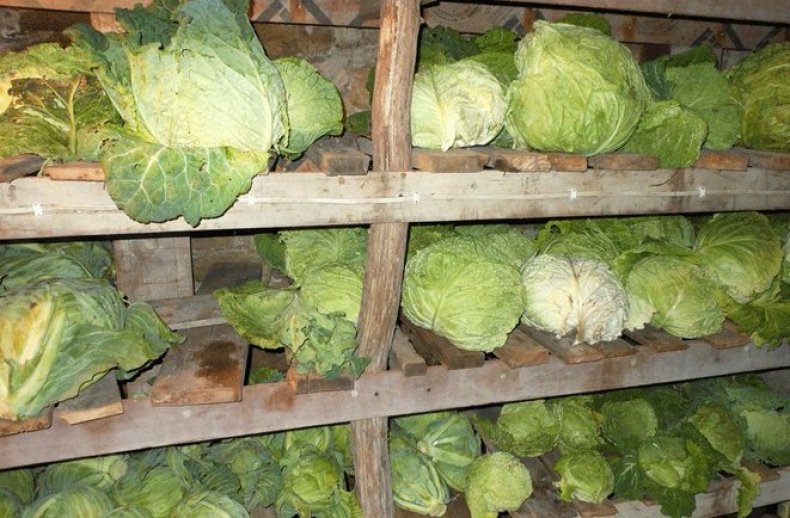
Important! The distance between the shelves should be such that about 0.1 m remains above the heads of cabbage for good air circulation.
In paper
Dried vegetables are taken for storage. The forks are wrapped in several layers of paper. It is allowed to use newspapers, only for the first layer there should be white blank paper. The paper layer does not allow the heads of cabbage to touch, it will serve as additional insulation from extreme cold, light and moisture. The forks wrapped in this way are laid out in boxes or bags.
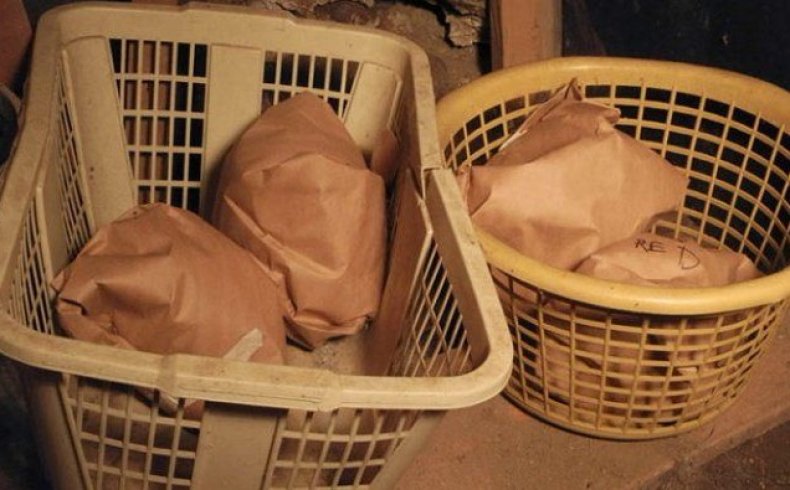
In cling film
This method is the most effective. The sequence of its implementation:
- elastic forks are taken;
- the leg is cut to the base and the covering leaves left;
- heads of cabbage are carefully wrapped in several layers of film, without folds, where air can remain;
- prepared cabbage forks are stacked on racks or in prepared containers;
- from time to time you should look at vegetables for the possibility of spoilage.
Video: storing cabbage in a film
In clay
A solution is prepared from two parts of clay and one part of water (the consistency of thick sour cream). The forks are coated with clay, the resulting "fur coat" is allowed to dry and the vegetables are laid out in the basement on the shelves.
Did you know? The largest cabbage in the world was grown in America in 2012. Her weight was 62.71 kg, which is recorded in the Guinness Book of Records.
In the sand or on a "pillow" of it
Sequence of operations:
- stalks are cut for leaves;
- put the heads of cabbage in a container made of wood so that they do not come into contact with each other;
- the first layer is covered with dry sand;
- lay out the next row of vegetables and sprinkle with sand;
- fill the box under the top.
Dry sand makes it possible to minimize crop losses. You can also save this vegetable on a "pillow" made of it: legs 8 cm long are left at the forks, dry sand is poured into small containers with a layer of 20 cm, prepared cabbage is inserted into it.
Check out the recipes for harvesting cabbage for the winter: in Georgian, salted, sauerkraut.
Aweigh
The cabbage is harvested by the roots, the soil is shaken off. The roots are tied tightly with twine, and the ventilated forks are suspended from the ceiling of the cellar. The main thing is that the forks do not touch each other. This method saves space well with a large harvest of vegetables and a limited storage area.
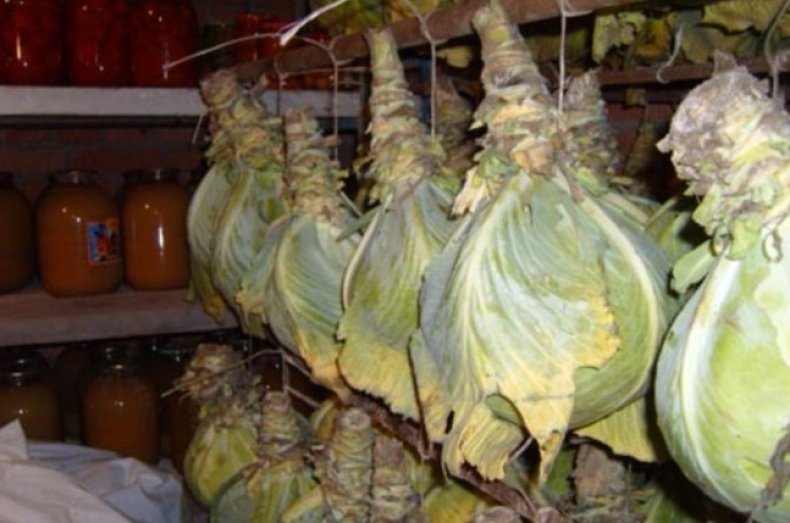
Step by step instructions
Storing cabbage in a garage pit:
- Harvest the cabbage.
- Cut off the legs, leave only the heads of cabbage.
- Dry if necessary and remove unsuitable leaves.
- Wrap each head of cabbage in plastic wrap.
- Lower into the pit of the garage.
Storing cabbage in a caisson:
- Harvest the cabbage.
- Cut off the legs, leave only the heads of cabbage.
- Peel off the topmost layer of leaves.
- Fold into wooden boxes.
- Sprinkle with sand if possible.
- Place the boxes on the floor of the caisson.
To store cabbage in cling film, you must:
- Dry the harvested heads of cabbage if necessary.
- Peel off one top layer of leaves.
- Wrap each head of cabbage with several layers of film.
- Fold into any convenient container or on the shelves.
Storing rooted cabbage:
- Dig up the cabbage by the root.
- Tie a rope to each head of cabbage by the leg.
- Hang the heads of cabbage for it from the ceiling of the cellar.
How to hang cabbage with root - photo:
Storing cabbage by cabbage:
- Harvest the cabbage.
- Remove the legs, leave only the heads of cabbage.
- Remove the top layer of leaves.
- Put the heads of cabbage in boxes, on shelves or in a pyramid, if desired, wrap with foil.
You will learn how to put cabbage in the cellar for storage using a vacuum cleaner by watching the video:
How to keep cabbage for the winter in a pile
So, with the question "is it possible to store cabbage in the cellar", you figured it out. But there is also another way. A rich harvest of cabbage is often stored in piles. Unlike potato tubers or root crops, heads of cabbage are not poured, but stacked one at a time in order to minimize the risk of mechanical damage. Vegetables on the surface are placed with stumps inward - this helps prevent freezing.
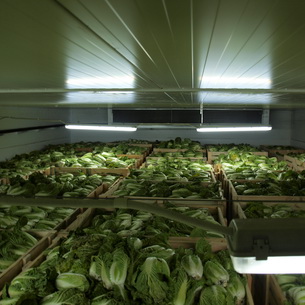
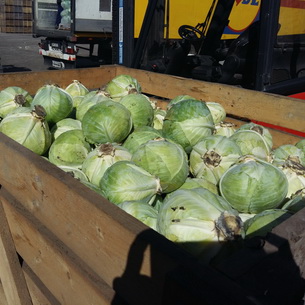
The most effective way of storing cabbage in bulk is in storage facilities with active ventilation. If the crop was harvested in cool, dry weather, the heads of cabbage are covered over the entire storage area with a continuous layer of 2.5 m.If the harvest was carried out in rainy weather, and the harvest is represented by less mature varieties, the heads of cabbage are placed in the storage in wide piles on both sides of the aisle. The passage is left so that, in the event of possible damage to vegetables, it is possible to take the necessary measures: sort out the products, clean or remove the affected heads of cabbage. Immediately after loading, the heads of cabbage are dried and cooled using intensive 15-hour ventilation. This procedure lasts for 10-12 days, since only then the final cooling of the cabbage mass will occur (drying usually takes much less time: about 3 days). But even after that, they continue to carry out ventilation daily for 3-4 hours.
At the same time, it is important to remember about such an important condition for storing cabbage in winter as the temperature of the supplied air: it must
not be below -1 ° C
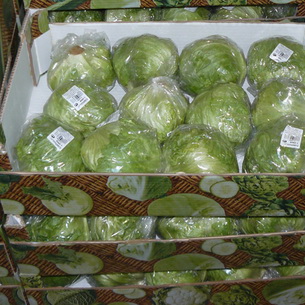
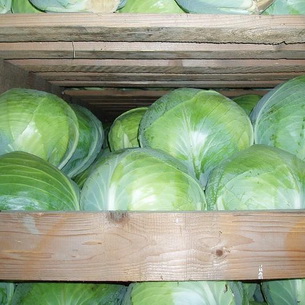
You can also store cabbage in naturally refrigerated rooms or refrigerators. In this case, the vegetables are also stacked. A good way to extend the shelf life of cabbage until June is with snowing. In central Russia, this method is used in late February or early March, when the air and snow temperature is about -3 ° C. Heads of cabbage intended for snow must be dense, well preserved, without damage or decay.
They snow cabbage, as a rule, in piles. Before storing cabbage in winter in this way, snow is compacted with a layer of 50–80 cm thick on a site about 4 m wide, and low snow walls are made on the sides. The cabbage is laid in rows, sprinkling each of them with a 10-centimeter layer of snow. Gradually, the collar is narrowed, and the top is covered with snow, peat and shavings. The height of the finished snow pile should be about 2 m. Snowing can also be used in storage facilities, but it is necessary to ensure the outflow of melt water.
Whichever method you choose, in any case, the mandatory storage conditions must be observed, the most important of which are temperature, humidity and composition of the gas environment.
Fresh cabbage storage methods
Proper organization will help to extend the shelf life of cabbage: so that there is an air gap between the heads of cabbage, and they do not press on each other with their own weight.
In film
Plastic wrap wrapped around the head in three layers keeps the necessary moisture level inside the fork so that its leaves do not dry out and remain crispy. This method is often used when storing cabbage in the refrigerator or on the balcony.
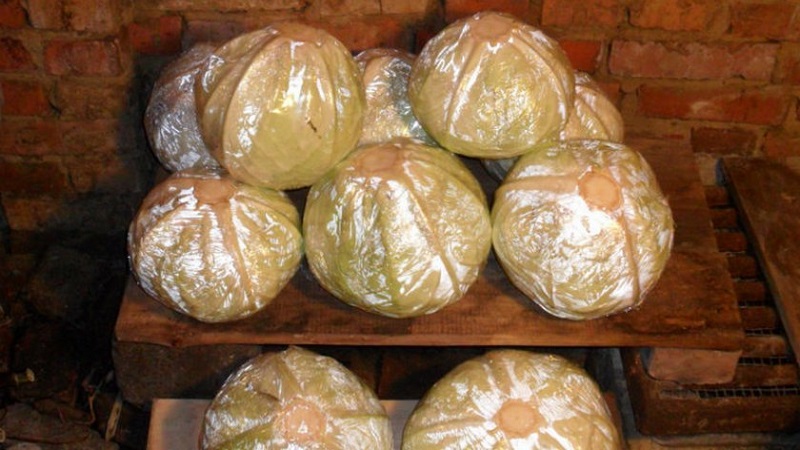
In paper
The paper provides additional thermal insulation, and the fully wrapped forks do not touch each other. Cabbage packed in this way can be stored in boxes and bags.
In the box
Due to the slots between the slats, the drawer is ventilated, therefore it is well suited for storing vegetables. The material of manufacture and the size of the container are not of particular importance.
The boxes are not stacked too tightly to each other. To provide air access, 10 cm are left between them on each side.
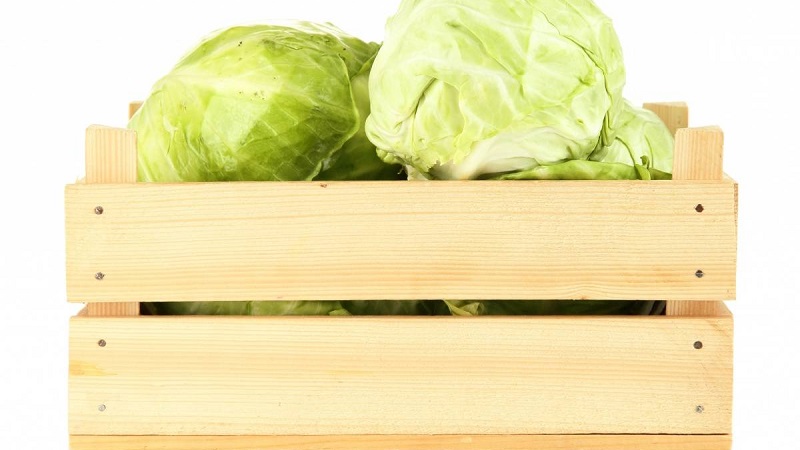
In the grid
The coarse mesh gives a good visual overview of the cabbage stored in it - this makes it easier to inspect stocks for damage without taking every head of cabbage out of the bag. Another plus is the ease of transportation, since the packaging weighs practically nothing.
It is better to stack bags and nets on wooden pallets or racks, rather than on a cold earthen floor.
In sand
The sand between the cabbage forks serves as a natural adsorbent and heat insulator, so it keeps stocks for as long as possible.
Several options for storing cabbage in the sand are described. The first allows you to arrange stocks more compactly:
- A generous layer of well-dried clean sand is poured onto the bottom of the wooden box.
- The heads of cabbage are laid out on top, stumps up.
- Sand is poured over the cabbage again and the layers are repeated this way until the box is full.
The second option can lead to rooting and sprouting of the vegetable:
- The bottom of the box is filled with sand by 20 cm.
- The forks are laid in one layer, sticking the stumps into the sand.
To exclude the appearance of pathogenic microflora, it is better to pre-ignite the sand. So it will also get rid of excess moisture.
In clay
To preserve freshness and a pleasant crunch, the cabbage can be wrapped in a “clay fur coat”. To do this, clay is mixed with water in a 2: 1 ratio to obtain the consistency of thick sour cream. Then they coat each head of cabbage and put it at a distance from each other so that the layer is completely dry. When the clay has hardened, the cabbage is placed on a shelf or in boxes.
Aweigh
To hang the cabbage from the ceiling, the stumps are kept as long as possible. One end of a strong non-slip thread (twine, twine) is tied around a stump, the other is fixed on any holders under the ceiling: beams, hooks, stretched ropes, etc.
The heads of cabbage suspended in this way do not cake, as they are well blown. They are always in sight, they can be examined from all sides. As a result, the cabbage stays fresh until summer.


